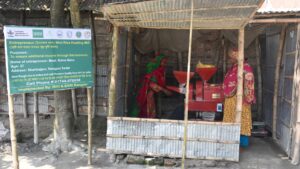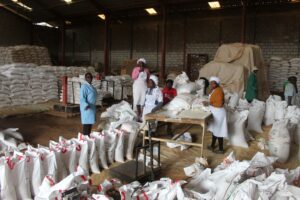by Jon Hellin, Eleanor Fisher, Marcus Taylor, Suhas Bhasme, and Ana María Loboguerrero
For approaches to be transformative, what is required is a broader and more comprehensive understanding and appreciation of farmers’ realities and the changes needed to foster large-scale transformation in their livelihood trajectories while avoiding or mitigating the dangers of maladaptation. This means that the climate response has to involve those from numerous disciplines across the natural and social sciences. Furthermore, it has to ensure that it is embedded in transformative adaptation with more focus on tackling the root cause of vulnerability and giving more emphasis to human development.
The agricultural sector is at the forefront of the climate crisis in terms of being a significant source of greenhouse gas emissions while also being adversely impacted by rising temperatures, droughts, and floods. Much agricultural research seeks to mitigate the impacts of climate-related risk and to enhance resilience in the face of climate variability and extremes.
One area of focus has been the development and scaling of climate-smart agriculture (CSA) that reduces greenhouse gas emissions, enhances adaptation, and contributes to food security, the triple win. CSA encompasses a broad array of agricultural technologies and practices, including stress-adapted crop germplasm e.g., drought-tolerant maize varieties; conservation agriculture; agroforestry; and soil and water conservation.
Once the seemingly correct technologies and management practices are identified, then the challenge comes to scale them up through widespread dissemination among target populations, a challenge that has been readily taken up by international organizations such as the Food and Agriculture Organization (FAO) and numerous NGOs.
Parallel to this emphasis on adaptation through climate-smart agriculture, the Intergovernmental Panel on Climate Change (IPCC) Working Group 2 report, Climate Change 2022: impacts, Adaptation and Vulnerability, highlights the danger that climate responses can inadvertently lead to detrimental impacts upon vulnerable groups. Recent scientific studies refer to this outcome as “maladaptation”.
Climate adaptation projects can reinforce existing vulnerabilities either by promoting adaptation interventions that benefit powerful elites or by transferring risks and exposures between groups rather than alleviating them. In other cases, actions undertaken in the name of adaptation create new risks and sources of vulnerability, often by neglecting the unintended outcomes of project activities.
Such maladaptive outcomes often stem from overly technical adaptation programming that is driven by outside objectives and knowledge and insufficiently considers the social and political dimensions of vulnerability. There is much literature that heralds the success of CSA, but the focus has tended to be on the climate change adaptation and mitigation benefits to agriculture rather than those related to human development.
Across the various institutional discourses and narratives around CSA, there is seldom sufficient emphasis on societal concerns, including attention to social norms or issues of inequality, power, and justice and the types of farmers who many benefit from agricultural interventions at the expense of more vulnerable and marginalized farmers.
The climate response has tended to be primarily technical in nature based on the premise that the climate challenge can best be resolved through the application of expert knowledge. CSA has typically been portrayed as a process of identifying and disseminating improved technologies and practices that can simultaneously advance the aforementioned triple-win goals, especially adaptation and mitigation.
Pointedly, it is precisely this notion of advanced technical innovation that provides the basis for putting the ‘smart’ in climate-smart agriculture. Increasingly a more nuanced picture is emerging, one that demonstrates that a failure to contextualize CSA in relation to the structural socio-economic and power dynamics associated with agricultural systems, which render some categories of farmer especially vulnerable to climate change, undermines CSA’s contributions to reducing rural poverty and may increase inequalities.
Resilience encompasses both agro- and socio-ecological dimensions and can be enhanced by embedding social equity in agricultural interventions. There is a need for transformative orientations that better incorporate social analysis and that foreground social equity concerns.
This new emphasis typically argues for adaptation initiatives to pursue a more deep-seated approach to social, institutional, technological, and cultural change in order to address the structural contributors to vulnerability and differential exposure to climate risk. Such approaches empower the affected communities.
Addressing these questions requires a robust consideration of the social contexts and power relations through which agriculture is both researched and practiced. In our view, it will be impossible to create transformative change without bringing social equity issues to the fore and tackling the issues of power relationships and decision-making within agricultural development.
The aforementioned IPCC report highlighted this with its emphasis on transformative adaptation and the need to tackle the root causes of vulnerability to climate change. The greater emphasis on social equity and human well-being distinguishes climate-resilient from climate-smart agriculture.
Transdisciplinary partnerships and systems approaches are needed to realize climate-resilient agriculture and ensure that agricultural interventions achieve adaptation and mitigation goals along with more equitable incomes, food security, and development.
CSA approaches have tended to downplay the danger of maladaptation, a consequence that often builds on extant inequalities and power relations within farming communities. CSA narratives are often ambiguous as to the procedural aspects of identifying, testing, and disseminating the innovations considered to achieve triple-win outcomes.
There is often an implicit emphasis on “success stories” that can be scaled up without due consideration of how social differences within target populations strongly shape who can benefit and how from such practices.
Research on climate adaptation must therefore seek to address core issues of whose priorities count.
In particular, researchers need to be explicit about the extent to which they, extension agents and smallholders themselves, converge on the priority areas for change and innovation.
Secondly, they need to explicitly consider how priorities diverge across smallholder populations in accordance with differences in asset holdings and gendered roles and responsibilities.
For approaches to be transformative, what is required is a broader and more comprehensive understanding and appreciation of farmers’ realities and the changes needed to foster large-scale transformation in their livelihood trajectories while avoiding or mitigating the dangers of maladaptation. This means that the climate response has to involve those from numerous disciplines across the natural and social sciences.
Furthermore, it has to ensure that it is embedded in transformative adaptation with more focus on tackling the root cause of vulnerability and giving more emphasis to human development. The focus necessarily shifts more to social equity governance and policy and less on technologies per se. To do so effectively, farming activities must be seen as one element of broader livelihood strategies, and the appropriateness of interventions within agriculture should be measured in that context.
Equally, it also requires greater attention to the active participation of farmers and farmer groups in defining the key challenges they face and discerning what might be appropriate innovations in response.
This is key to avoiding the production of maladaptive outcomes resulting from overly centralized and top-down approaches. A paradigm shift from climate-smart to genuine climate-resilient agriculture allows for this because of its systems approach, emphasis on adaptive capacity, and above all its social equity focus.
Read the study:
Hellin J, Fisher E, Taylor M, et al. (2023) Transformative adaptation: from climate-smart to climate-resilient agriculture. CABI Agric Biosci 4, 30







This is a very interesting and thought provoking piece.
However, how do we operatilise the term climate resilient approach and what differentiates transformative adaptation from adaptive one.
Many thanks Daniel for your questions.
We argue that operationalizing climate resilience requires factoring in a social equity approach. For more details please see this open access article https://iopscience.iop.org/article/10.1088/2752-5295/ac8b9d
Transformative adaptation is more radical and far-reaching than adaptation as it is tackles the root causes of vulnerability, embraces issues of political economy and power balances among different actors. Again, please see the open access article referred to above.
Best wishes,
Jon